|
|
|
Sort Order |
|
|
|
Items / Page
|
|
|
|
|
|
|
| Srl | Item |
| 1 |
ID:
128232
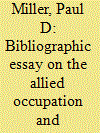

|
|
|
|
|
| Publication |
2013.
|
| Summary/Abstract |
There is no definitive, single-volume history of the Allied occupation and reconstruction of West Germany from 1945 to 1955. This is a significant and surprising lacuna in the literature on US and European history, international relations, and the rapidly growing field in reconstruction and stabilization operations. Scholars, historians, and policymakers need a comprehensive treatment of the German occupation. There is now an opportunity to fill that need. This bibliographic essay reviews the wealth of source material that has become available in recent decades. We can now synthesize primary sources and specialized scholarship to tell the story, for the first time, of how the Allies occupied and rebuilt the western part of Germany.
|
|
|
|
|
|
|
|
|
|
|
|
|
|
|
|
| 2 |
ID:
172256
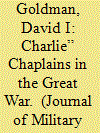

|
|
|
|
|
| Summary/Abstract |
Following World War I, the U.S. Army began drafting a comprehensive history of its wartime activities, including a section on chaplains, but by 1920 the project had fallen victim to a wave of budget cuts. What remained of the chaplain’s portion was an incredibly rich collection of letters, photos, and documents compiled by a group of chaplains tasked with writing the section. The author came across these little-used files, and he has used them as the basis to tell a part of the story of the priests, reverends, and rabbis who decided to serve both their nation and denominations in the war.
|
|
|
|
|
|
|
|
|
|
|
|
|
|
|
|
| 3 |
ID:
189083
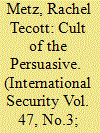

|
|
|
|
|
| Summary/Abstract |
Security assistance is a pillar of U.S. foreign policy and a ubiquitous feature of international relations. The record, however, is mixed at best. Security assistance is hard because recipient leaders are often motivated to implement policies that keep their militaries weak. The central challenge of security assistance, then, is influence. How does the United States aim to influence recipient leaders to improve their militaries, and what drives its approach? Influence in security assistance can be understood as an escalation ladder with four rungs: teaching, persuasion, conditionality, and direct command. Washington increasingly delegates security assistance to the Department of Defense, and the latter to the U.S. Army. U.S. Army advisers tend to rely exclusively on teaching and persuasion, even when recipient leaders routinely ignore their advice. The U.S. Army's preference for persuasion and aversion to conditionality in security assistance can be traced to its bureaucratic interests and to the ideology that it has developed—the cult of the persuasive—to advance those interests. A case study examines the bureaucratic drivers of the U.S. Army's persistent reliance on persuasion to influence Iraqi leaders to reform and strengthen the Iraqi Army. Qualitative analysis leverages over one hundred original interviews, as well as oral histories and recently declassified U.S. Central Command documents. The findings illustrate how the interests and ideologies of the military services tasked with implementing U.S. foreign policy can instead undermine it.
|
|
|
|
|
|
|
|
|
|
|
|
|
|
|
|
| 4 |
ID:
134080
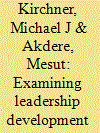

|
|
|
|
|
| Publication |
2014.
|
| Summary/Abstract |
The existing literature presents ample studies on leaders and leadership development in the United States Army. The contribution of many great military leaders of the U.S. are widely recognized both by the military community and the society at large. Reviewing the history of leadership development (LD) in the U.S. Army provides an opportunity to analyze American soldiers' development and transformation as strong leaders. Although U.S. Army training and its value systems, in many ways, have remained fundamentally the same with focus on hierarchy and structure, LD has been repeatedly refined, reframed, and redesigned based on the needs of the time and expectations of the leadership. This paper presents a review of the LD training in the U.S. Army to identify potential opportunities for the military of the Republic of Korea. It focuses on LD throughout critical periods in the history of the U.S. Army and illustrates how LD training has evolved historically. The paper also explores how Human Resource Development (HRD) as a discipline of study and its functions may be instrumental in LD by analyzing the U.S. Army's approach to LD, leadership training, organizational culture, and career development. Implications of LD for security and defense strategies are also discussed.
|
|
|
|
|
|
|
|
|
|
|
|
|
|
|
|
| 5 |
ID:
189919
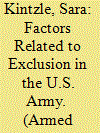

|
|
|
|
|
| Summary/Abstract |
The promotion of inclusion in the U.S. Army requires an understanding of how and why exclusion occurs. As exclusion can have deleterious impacts at both and individual and organizational level, reducing exclusive behaviors can have positive effects on Soldiers and the Army. To explore exclusion in the Army, 19 focus groups were conducted with 120 active-duty enlisted Soldiers. Two rounds of thematic analysis revealed four themes related to exclusion. Participants indicated exclusion to be often based on low or bad performance, personality factors that were identified as different or toxic, cliques within the Army unwilling to welcome others, and gender, with both men and women identifying exclusionary behaviors toward women within and outside of the work environment. Research findings offer insight into how and why exclusion occurs and how such behaviors can be addressed in the U.S. Army including training and addressing cultural and systemic barriers to inclusion.
|
|
|
|
|
|
|
|
|
|
|
|
|
|
|
|
| 6 |
ID:
187238


|
|
|
|
|
| Summary/Abstract |
During the ten years following the armistice in Korea, the U.S. Army described its basic training for enlisted male soldiers as a process that transformed civilians into men tough enough to withstand the rigors of a war with the Soviet Union. There was, however, during these years great dissatisfaction with this program. Critics both inside and outside the service found a variety of faults, but the one most frequently cited was the quality of officers and sergeants assigned to shepherd recruits through the transition from civilian to soldier. Despite frequently praising the drill instructor concept used in Marine Corps basic training, senior army officers refused to adapt it for use in their service’s training centers. Effective change, in the form of the drill sergeant program, would come only after intervention into a core military function by Cyrus R. Vance and Stephen Ailes, successive secretaries of the army.
|
|
|
|
|
|
|
|
|
|
|
|
|
|
|
|
| 7 |
ID:
159438
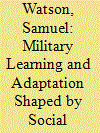

|
|
|
|
|
| Summary/Abstract |
The regular army, rather than citizen-soldiers, drove nineteenth-century U.S. military history (apart from the Civil War). The national standing army was crucial to the defeat of Native Americans, and more important than citizen-soldiers or white pressure on Native American subsistence. Despite new circumstances west of the Mississippi River, the contexts and methods of this warfare did not fundamentally change, and learning (or relearning) and adaptation were crucial to the army’s success. The most important learning was strategic, particularly in lessons of patience, persistence, and control over the initiation and conduct of warfare, and responded to external, non-military contexts (the tug of war between citizen land hunger and tax aversion). Army learning and adaptation did not win these wars by itself, but it facilitated the effective and successful use of force at a cost the nation was willing to pay, and reduced the incidence of large-scale atrocity in comparison with operations by citizen-soldiers.
|
|
|
|
|
|
|
|
|
|
|
|
|
|
|
|
| 8 |
ID:
179192
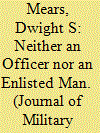

|
|
|
|
|
| Summary/Abstract |
U.S. Army contract surgeons in the nineteenth century were in many ways indistinguishable from their commissioned counterparts; however, as civilians they were treated quite differently when it came to some legal entitlements, which included eligibility for the sole military decoration of the period, the Medal of Honor. This article compares the experiences of four different contract surgeons who claimed entitlement to the Medal of Honor and the varying outcomes. These case studies offer a window into the various power structures of the time, demonstrating that some military awards were influenced by gender, influence, timeliness, and merit relative to other potential recipients.
|
|
|
|
|
|
|
|
|
|
|
|
|
|
|
|
| 9 |
ID:
090370
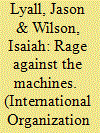

|
|
|
|
|
| Publication |
2009.
|
| Summary/Abstract |
During the nineteenth century, states routinely defeated insurgent foes. Over the twentieth century, however, this pattern reversed itself, with states increasingly less likely to defeat insurgents or avoid meeting at least some of their demands. What accounts for this pattern of outcomes in counterinsurgency (COIN) wars? We argue that increasing mechanization within state militaries after World War I is primarily responsible for this shift. Unlike their nineteenth-century predecessors, modern militaries possess force structures that inhibit information collection among local populations. This not only complicates the process of sifting insurgents from noncombatants but increases the difficulty of selectively applying rewards and punishment among the fence-sitting population. Modern militaries may therefore inadvertently fuel, rather than deter, insurgencies. We test this argument with a new data set of 286 insurgencies (1800-2005) and a paired comparison of two U.S. Army divisions in Iraq (2003-2004). We find that higher levels of mechanization, along with external support for insurgents and the counterinsurgent's status as an occupier, are associated with an increased probability of state defeat. By contrast, we find only partial support for conventional power- and regime-based explanations, and no support for the view that rough terrain favors insurgent success.
|
|
|
|
|
|
|
|
|
|
|
|
|
|
|
|
| 10 |
ID:
138444
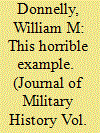

|
|
|
|
|
| Summary/Abstract |
The decision in 1965 to expand the U.S. Army's active force without a reserve mobilization quickly generated massive organizational turbulence. In this environment one unwilling soldier found an extraordinary opportunity to slip away.
|
|
|
|
|
|
|
|
|
|
|
|
|
|
|
|
| 11 |
ID:
089130
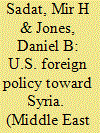

|
|
|
|
|
| Publication |
2009.
|
| Summary/Abstract |
To the Muslim world, we seek a new way forward, based on mutual interest and mutual respect. To those leaders around the globe who seek to sow conflict or blame their society's ills on the West, know that your people will judge you on what you can build, not what you destroy. To those who cling to power through corruption and deceit and the silencing of dissent, know that you are on the wrong side of history but that we will extend a hand if you are willing to unclench your fist.
|
|
|
|
|
|
|
|
|
|
|
|
|
|
|
|
|
|
|
|
|